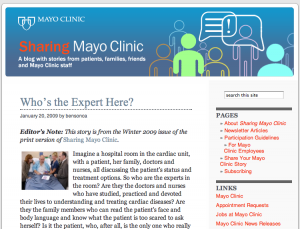In my presentation at Blogwell, at which I introduced our new Mayo Clinic blog for patients and employees, Sharing Mayo Clinic, I closed with a Jerry Maguire appeal:
[youtube=http://www.youtube.com/watch?v=p-oHuogx6_Y]
Many of the questions I got after the presentation, and that I get in other contexts from people wanting to implement social media programs at work, began something like: “What about the concerns that …” or “What about the fears that ….”
One of my points in response is that it’s extremely helpful to have external consultants who can help reassure leadership that the social media advocates in the organization aren’t crazy, and that lots of other companies and similar groups are using blogs and social media successfully, and without major problems. Shel Holtz and Andy Sernovitz helped us.
It’s also great to be able to point to examples of success, like Nuts about Southwest.
I hope Sharing Mayo Clinic can be the kind of example you can show your leaders, and say “See! If an established organization like Mayo Clinic is using blogs and Facebook and YouTube, we can too.” I’d love it if our example can help you fight the FUD (fear, uncertainty and doubt) barrier in your organization.
Of course, a big part of you being able to use our blog as an example of corporate blogging success is…well…for us to succeed.
You can help me with that in two ways: Suggesting Improvements and Spreading the Word.
Suggesting Improvements. In response to the post I did announcing the blog Thursday, SMUGgle Scott Meis (who I got to finally meet for the first time at BlogWell), left a good suggestion in the comments that I have implemented. It tripled the number of RSS and email subscribers we got in the second full day of the blog’s operation, as compared to the first. So, I hope you’ll check out Sharing Mayo Clinic, and I’d really appreciate any further suggestions you could offer on how we can improve.
Spreading the Word. Obviously building traffic to Sharing Mayo Clinic is our responsibility, and we’re communicating with our Mayo Clinic patients and employees about it. But if you would help spread the word by blogging or tweeting about it, or posting it on your Facebook profile or sending it to your friends, that would be fantastic, too.
And hopefully by helping me, I can help you fight the FUD.
